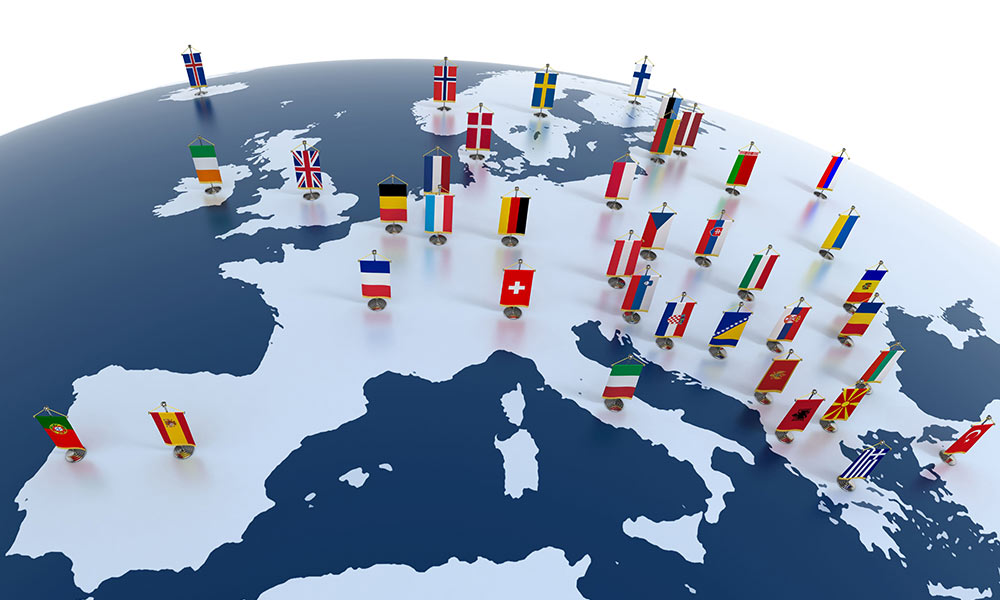
Overview Development and origin of trade mark applications
In 2024, the DPMA received 80,365 trade mark applications; this represents an increase of 2.1% compared to the previous year. The national applications (77,221) even rose by 2.6%, whereas the requests for protection in Germany transmitted to us by the World Intellectual Property Organization (WIPO) decreased by 8.4% to 3,144.
This means that, despite the economic downturn, the moderate but constant increase in trade mark applications in the past years continued. As we already saw during the years of the COVID-19 pandemic with their unexpectedly strong increases in trade mark applications, the general trend is difficult to predict. According to examiners, there are many creative trade mark applications that reflect individual trends in an astonishingly short time. Rapid economic and social changes result in changing life circumstances, which require new solutions and new trade marks. In 2024, besides the popular topics of the past years, such as energy transition and vegetarian or vegan nutrition, applications relating to artificial intelligence stood out.
At the European Union Intellectual Property Office (EUIPO), there were 22,080 applications from Germany, nearly unchanged from the previous year (22,173). In total, however, the EUIPO saw an increase to 180,447 applications, up 2.7% from 175,711 applications in 2023. At theEUIPO, applications from China rose significantly from 23,755 to 27,516. This means that China was once again the most frequent country of origin for an EU trade mark application (Source: EUIPO Statistics for European Union Trade Marks, Februar 2025). With 3,376 applications, China was also the country from which the DPMA received by far the majority of foreign applications.
As in the previous year, trade mark applications mainly concerned the following: class 35 (advertising; business management, organisation and administration; office functions), ahead of class 41 (providing of training, entertainment; sporting and cultural activities) and class 9 (electrical apparatus and instruments; computer hardware; software; optical apparatus and instruments). Class 35 was (one of the classes) indicated in 23,986 applications, i.e. for one out of three trade marks.
At the EUIPO, class 9 (47,074 applications) was ahead of class 35 and class 42.
Top 51 Classes2 of goods and services
2 A trade mark application can be attributed to several classes.
In terms of 100,000 inhabitants, the highest number of registrations again came from the city states of Hamburg and Berlin, both of which are home to many companies. The industrially strong territorial states of North Rhine-Westphalia and Bavaria took 3rd and 4th place, followed by Bremen in 5th place, moving up 4 places.
The map shows the trade mark applications in 2024 and the applications per 100,000 population as well as the percentage change, broken down by German Land (residence or principal place of business of the applicant).
In 2024, 49,991 trade marks were registered in the register, a slight increase compared to the 48,689 registrations in the previous year. Due to formal deficiencies or a lack of protectability, 7,343 applications were refused, far less than a tenth of the new applications. 17,318 applications were withdrawn or were deemed withdrawn. A deemed withdrawal, i.e. if the application fee is not paid within the payment period of three months from the date of filing of the application, allows applicants to file trade mark applications claiming the date of filing as the date of seniority while they have three months to decide whether or not to pursue the application.
We received 87.1% of the national applications online via the two filing options DPMAdirektPro and DPMAdirektWeb, another increase by 2.2 percentage points compared to the previous year. In particular, filing an application without signature via DPMAdirektWeb offers important benefits especially to inexperienced applicants. A dialogue in the online filing process helps avoid formal errors that delay processing. The shopping cart function offers great advantages to indicating the goods and services. Thanks to a search function, applicants can search the appropriate goods and services from a database with more than 73,000 entries. The terms originate from an international harmonised database and are accepted by us and many other countries without further review.
| Selected data | 2020 | 2021 | 2022 | 2023 | 2024 |
|---|---|---|---|---|---|
| New applications | 84,623 | 87,649 | 73,312 | 75,261 | 77,221 |
| Registrations | 60,445 | 68,638 | 53,636 | 48,689 | 49,991 |
| Refusals | 6,606 | 9,634 | 7,793 | 6,629 | 7,343 |
In the 2024 ranking, Boehringer Ingelheim International GmbH took first place with 135 registrations, followed by Point Commerce B.V. with 95 registrations and Henkel AG & Co. KGaA with 56 registrations.
At the Jena location, 40 staff of the trade mark administration deal with secondary procedures after the definitive registration of a trade mark. Secondary procedures in particular include renewals, the recording of changes, restrictions on disposal, divisions, licensing procedures and cancellations. Other horizontal tasks the trade mark administration staff perform are issuing priority documents, certifications of origin and other register extracts and providing internal services, e.g. quality assurance tasks, including corrections of the trade mark register.
At the end of 2024, the register contained 897,701 trade marks. With respect to 103,620 trade marks, changes concerning proprietors, representatives or addresses of service were made. The number of trademark cancellations due to non-renewal of the term of protection or surrender, due to opposition or following the conclusion of revocation/cancellation proceedings increased slightly to 41,032 (previous year: 40,536). Renewals also slightly increased from 34,296 to 35,891. Declarations of willingness to license or sell/transfer continued to gain importance: the DPMA received non-binding declarations of willingness to grant licences from the respective registered proprietors with respect to 31,890 trade marks (previous year: 28,128); yet a licence was entered in the register for only 7 trade marks. It also received declarations of willingness to sell/transfer with respect to 16,072 trade marks (previous year: 14,396).
For further statistical data on trade mark administration, please see the “Statistics”.
Since 1 May 2020, there has been the option to file an application for a declaration of invalidity due to the existence of earlier rights or an application for revocation not only with an ordinary court but also with the DPMA, and to have the proceedings fully conducted at the latter. At the DPMA, a panel consisting of three legal examiners decides on such applications.
In 2024, the DPMA received 115 applications for a declaration of invalidity due to the existence of earlier rights (previous year: 105) and 182 requests for initiation of revocation proceedings intended to have a substantive decision (previous year: 169).
In addition, 152 applications for a declaration of invalidity due to the existence of absolute grounds for refusal were filed (previous year: 151), of which 68 concerned the ground for refusal that a trade mark application had been filed in bad faith (previous year: 73).
Several of the cases decided by the DPMA since 2020 have been challenged by way of an appeal to the Federal Patent Court, which has so far rendered a decision on two cases. In both cases (trade marks “VIVA” and “ADLON”), the Federal Patent Court fully affirmed the decision of the trade mark division.

In focus Qualification for trade mark examination
A highly skilled team for your protection
What do you need for a strong trade mark protection? Thoroughly prepared applications — and competent examinations. This is why the DPMA has developed a comprehensive qualification concept that equips our examiners with all the skills they need to do an excellent job.

For some years now, the new examiners of the trade mark division have been receiving internal training in line with a unified qualification concept. This comprehensive, top-quality and up-to-date training helps create a team of independent examiners capable of making decisions, and the centralised learning process ensures a unified decision standard.
The qualification concept consists of various modules that cover practical skills as well as theoretical foundations. The first onboarding period in the team for the initial classification and the introduction to the formal administrative processes of the application and opposition procedures are followed by the (reduced) work on cases, which is accompanied by a three-year qualification in legal theory. Due to the concept’s modular structure and the fact that currently there are different training phases taking place simultaneously, it is possible for staff to pause their participation for personal or work-related reasons and then continue with the modules of the next course at a later point.
The training in detail
The training in legal theory starts with the one-year substantive course “Absolutes Verfahren” (absolute procedure), which is accompanied by the team’s experienced examiners on an individual basis (mentoring). In this course, the new examiners get to know the formal and substantive requirements for the registration of a trade mark in small groups. At this stage, the participants will apply their newly acquired knowledge by drafting their own decisions, which they will complete under supervision until they are ready to be sent out. This way, new staff are involved in every step of the process from the very beginning.
Once this phase has been successfully completed, the nine-month advanced stage starts. Now, junior examiners support their teams by independently working on their own cases from application until registration. This enables them to put their substantive skills into practice and learn to manage their workload.
The last stage consists of the one-year substantive course “Widerspruchsverfahren” (opposition procedures), which, just like the other course, is also held by trade mark lawyers. Here, the examiners learn the adjective and substantive legal requirements for a successful opposition against a newly registered trade mark, with the focus on the likelihood of confusion between two trade marks. As before, the participants draft their own decisions, which they then revise and finalise together with their mentors so they can be sent out.
After the successful completion of their training, the examiners are granted signing authority and receive their own cases. Since the new examiners have already been closely involved in the day-to-day business during their training, they can now start supporting the trade mark team as a full-fledged member without any further delays.
30 years ago When trade mark law became European
30 years ago, an important development for the European single market came into force in Germany: the German Trade Mark Act took effect, implementing the European Trade Mark Directive. It was a crucial step for the harmonisation of legislation on behalf of the applicants. Since then, European and national law have been complementing each other marvellously.

30 years ago, on 1 January 1995, the Trade Mark Act (Markengesetz) took effect. It implemented the European Directive 89/104 (EEC) of 1989 to approximate the laws of the Member States relating to trade marks into German legislation, meaning that the European trade mark law now also applied to Germany. From this point on, the German Patent and Trade Mark Office has been examining the eligibility of trade marks for protection, the likelihood of confusion and the requirements for the cancellation of a trade mark in accordance with European rules. Especially the conditions for registering a trade mark have been the same in all of the EU since then: the harmonised European trade mark law was an important step towards making the European single market a reality.
Since 1 January 1993, members of the single market of the EU have benefitted from four fundamental rights: the free movement of goods, people, services and capital. To accomplish this, harmonising the legislation in member states and at European level was and still is crucial.
The first European Trade Mark Directive of 21 December 1988 already brought about a harmonisation of substantive trade mark law in the member states. Since its adoption, the requirements for registering a trade mark have been the same in all EU countries. The Regulation of 20 December 1993 on the Community trade mark completed the European legal framework and created the Community trade mark as well as the competent European trade mark office under its earlier name, “Office for Harmonisation in the Internal Market” (OHIM). From then on it has been possible to obtain the protection of a trade mark in all EU member states via just one registration procedure.
To gain more insights into the results of these first harmonisation measures, the European Commission put a trade mark study out for tender in 2009 and awarded it to the Max Planck Institute for Intellectual Property and Competition Law in November 2009. The results of the study that the Institute presented to the Commission in December 2010 showed that the coexistence of the national offices and the harmonisation office should be maintained and even strengthened. A further harmonisation measure should cast a wider net regarding substantive law and, for the first time, also take into account procedural aspects as well as office standards regarding classification and fee structures.
In 2015, the study results as well as suggestions from the European Parliament led to the new trade mark law Regulation and the amending Council Regulation on the Community trade mark regulation, which replaced the Community trade mark with the EU trade mark and the OHIM with the European Union Intellectual Property Office (EUIPO).
In Germany, the new Regulation was implemented as the Trade Mark Law Modernisation Act (Markenrechtsmodernisierungsgesetz, MaMoG). Apart from some provisions being adapted to the European terminology and a harmonisation of procedures, especially for opposition proceedings, the MaMoG also introduced various changes to substantive trade mark law, e.g. the establishment of new trade mark types.
The most important aspects for all parties, offices and users alike, are consistent provisions, low red tape and transparent procedures. To achieve these goals, the DPMA has continuously and intensely been working together with the EUIPO in various projects and working groups regarding the harmonisation of the trade mark procedures. And even after 30 years it can still be said that the European and the national trade mark system exist side by side in harmony and complement each other to the advantage of applicants. At the same time, the national German trade mark still has an important place in the IP strategies of companies and strengthens the economic basis of their business models.
Briefly explained Shaping the future with new types of trade marks
Sound mark, multimedia mark, hologram or “signature move”: as long as there are no grounds for refusal, all these types of trade marks can be registered. The many different marks were created to meet the needs of the market — and may also offer attractive new possibilities for your brand.

The Trade Mark Law Modernisation Act of 2019 created a more liberal framework for the types of trade marks that are eligible for registration in Germany. Since its implementation, a trade mark does not necessarily have to be graphically representable (as an image) anymore. Rather, it simply needs to be representable in a way that allows all users of the register to clearly and precisely determine its elements. This opens up many new opportunities for applicants, also in regard to their strategy.
Types of representation
Beside the conventional graphic representation of word marks and word/figurative marks, trade marks can now also be represented in the electronic register by using the file formats MP3 and MP4. This method is ideal for non-music sound marks, multimedia marks or light marks as well as, under certain circumstances, tactile marks.
If a mark cannot be represented in any other way, the very liberal German trade mark law also permits the representation solely in text form, as long as it allows for the clear and precise identification of the mark. This type of representation could enable the registration of conceptual trade marks, e.g. a store that has a very specific room temperature.
The new types of trade marks are especially appealing to applicants from the e-commerce sector, as they offer a range of interesting strategic possibilities. For example, sound marks and multimedia marks are ideal for websites or apps: a moving logo or a short video sequence that appears upon opening an app or a specific sound that confirms the payment process on a smartphone are excellent ways to distinguish a brand from competitors. The branding can even be continued in the metaverse: whether the avatars of employees or virtual products — all of this can be protected as a trade mark.
Technology keeps evolving, and the habits of consumers keep changing. The German trade mark law has adapted to these new developments — take advantage of its possibilities!
You can find explainer videos showcasing the new types of trade marks on our YouTube channel (German with English subtitles). If you click on this link, you will leave our website and open an external link to YouTube.
For more information about trade mark protection, please visit our website.